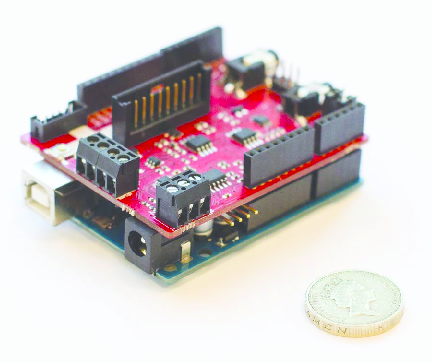e-Health sensor platform
The e-Health Sensor Platform [i] by Spanish electronics manufacturer Libelium is an open physiological monitoring platform using nine different sensors: pulse, oxygen in blood (SpO 2 ), airflow (breathing), body temperature, ECG, glucometer, galvanic skin response, blood pressure (sphygmomanometer) and patient position (accelerometer). The platform, shown in figures 3 and 4, consists of a board or shield that plugs into an Arduino or Raspberry Pi and interfaces with the various sensors, allowing for experimenting directly with the signals coming from these sensors.
To build the device a Raspberry Pi or Arduino is required. No special skills are required, as it comes as a modular kit where the various components are just plugged in. The components provided are off-the-shelf sensors and products that have been modified to work with the kit. Source code is available for Raspberry Pi and Arduino.
OpenBCI
OpenBCI is an eight-channel EEG signal capture platform (see figure 5) of which the hardware, software and mechanical design files are available online. [ii] It is intended for human brain-computer interface technologies, but the hardware can also be used to perform other types of biosensing, like EMG and heart rate (EKG).

Figure 3 Arduino (bottom, showing USB connector) and e-Health shield. UK £1 coin (2.25 cm diameter) for scale. (Photo by Patrick Oladimeji, image licensed under the Creative Commons BY-SA license).
All hardware and electrodes are included with the kit. It comes as a modular kit, with the hardware design files available. A 3D-printable EEG headset, called Spiderclaw, is in development. Source code is available for Arduino (8-bit), ChipKit (32-bit), Processing and Python.
Do-it-yourself blood pressure monitor
Russell et al [iii] published instructions to build a do-it-yourself (DIY) blood pressure monitor. The instructions include a bill of materials and circuit diagrams. The blood pressure monitor relies on an electronic pressure sensor connected to an aneroid sphygmomanometer (a mechanical type with a dial). The monitor runs on batteries that can be recharged using a hand crank generator. They do mention that it is an experimental prototype and that the measurements should not berelied on for clinical use.

Figure 4 Blood glucose meter connected to e-Health shield (Photo by Patrick Oladimeji, image licensed under the Creative Commons BY-SA license).
The device can be built using basic tools from a home hardware store. The various electroniccomponents that can be sourced from distributors, as well as an off-the-shelf sphygmomanometer. An off-the-shelf project box is used to contain the electronics. Source code is available for a Microchip PIC microcontroller, and only basic knowledge of electronics and soldering is required.

Figure 5 OpenBCI brain-computer interface (Photo by Wikimedia Commons, image licensed under the Creative Commons BY-SA license).
[i] Libelium Comunicaciones Distribuidas S.L. e-Health Sensor Platform V2.0 for Arduino and Raspberry Pi. http://www.cooking-hacks.com/documentation/tutorials/ehealth-biometric-sensor-platform-arduino-raspberry-pi-medical/. http://www.webcitation.org/6Yc5uii53
[ii] OpenBCI. http://www.openbci.com/. http://www.webcitation.org/6YgdlKXD8
[iii] Russell A, Orchard G, Reiley C. DIY blood pressure monitor. Make 2012;20:70–7.

